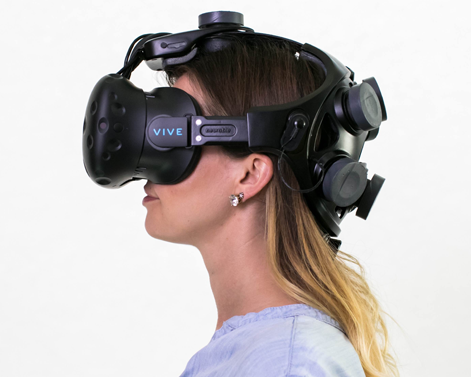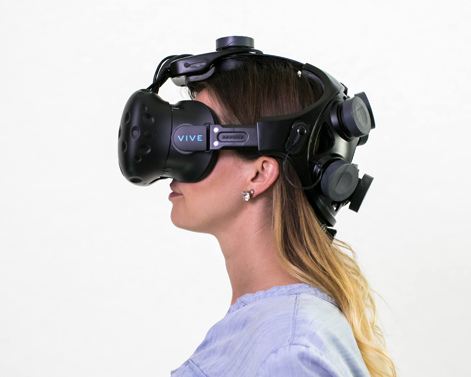EEG Systems
EXG and Biometric Solutions
DSI VR300
-
The DSI-VR300 is a research-grade dry electrode EEG system specifically designed for P300 applications and VR integration. The system comprises of ultra-high impedance active Dry Sensor Interface (DSI) sensors that function through hair, requiring no skin preparation or conductive gels. Sensors can be individually adjusted to optimize contact impedance. The design interfaces seamlessly with the HTC-Vive VR headset. A virtual reality-specific API developed by Neurable allows for rapid integration of P300 elements into the VR environment.
-
The DSI VR300 is a fully integrated, adjustable, and comfortable dry electrode EEG headset with wireless triggering.
Uncompromising Signal Quality
The DSI-7’s practicality, portability, and high signal quality opens the door to taking numerous applications that require rapid and non-intrusive EEG recording. Such applications include:
- ㆍActive dry electrode sensors with 2-stage amplification and
digitization in the headset - ㆍResearch-grade EEG signal (>90% correlation with
conventional wet electrode systems) - ㆍPatented artifact-resistant electro-mechanical designs
suitable for ambulation in naturalistic environments
Practical EEG
- ㆍFully integrated, complete EEG system in a single device
- ㆍRapid set-up (< 2 min) and clean-up time (< 1 min)
- ㆍAdjustable to fit a wide range of head sizes
- ㆍComfortable for continuous and repeated use
Powerful Options
- ㆍWireless triggering for synchronization of multiple devices
for hyperscanning or ambulatory ERPs - ㆍBluetooth or wired-USB transmission
- ㆍOptional embedded 3D accelerometers
Intuitive Software Included
- ㆍDSI-Streamer: Signal quality metrics, ERPs
- ㆍFile formats: EDF, CSV (filtered and raw)
- ㆍC-based API for Windows/Mac/Linux
- ㆍLSL, TCP/IP streaming
VR Interface by Neurable
- ㆍSeamless integration with HTC-Vive
- ㆍUnity and Unreal engine integration
- ㆍEmbedded real-time P300 analysis
- ㆍDemo software and code available
Synchronized Interfaces
- ㆍEye-tracking
- ㆍMotion capture
- ㆍNeuroGuide / BrainSurfer
- ㆍEEGLAB / ERPLAB /BCILAB
- ㆍMensia / Neuro RT / OpenVibe
- ㆍTEA Ergo CAPTIV
- ㆍBCI2000
- ㆍE-Prime
- ㆍInquisit
- ㆍPresentation
| Sensor Locations | 7 sensors at 10/20 locations (default): FCz, Pz, P3, P4, PO7, PO8, Oz + Linked Ears |
| Common-Mode-Follower | P4 is default reference (can be changed to LE in software) |
| Ground | A1 |
| Amplifier/Digitizer | 16 bits, 7 channels |
| Analog/Digital Resolution | 10 m |
| Analog/Digital Converter | 16 bits |
| Sample | 300 Hz (600 Hz option) |
| Bandwidth | 0.003-150 Hz |
| Gain | 60 |
| Common Mode Rejection Ratio | >120 dB |
| Channel Cross-Talk | < -70 dB with sensors |
| Input Impedance (1Hz) | 47 Gohm |
| Input Bias Current | <25 pA |
| DC Offset Tolerance | +/-200 mV |
| Maximum Input Range | 10mV pk-pk |
| Noise (1-50Hz) | <3 uV peak-peak |
| Digital Inputs | 4-bit input |
| Run-time | >12 Hours |
| Wireless | Bluetooth |
| Wireless Range | 10 m |
| Headset weight | ~400 g |
| Headsize Fit | Adjustable to a wide range of head sizes |
| Headset | Fixed sensors on spring-loaded arms and pods for sensor support |
| Notice | * Specifications subject to change, please contact us to obtain latest specifications |



